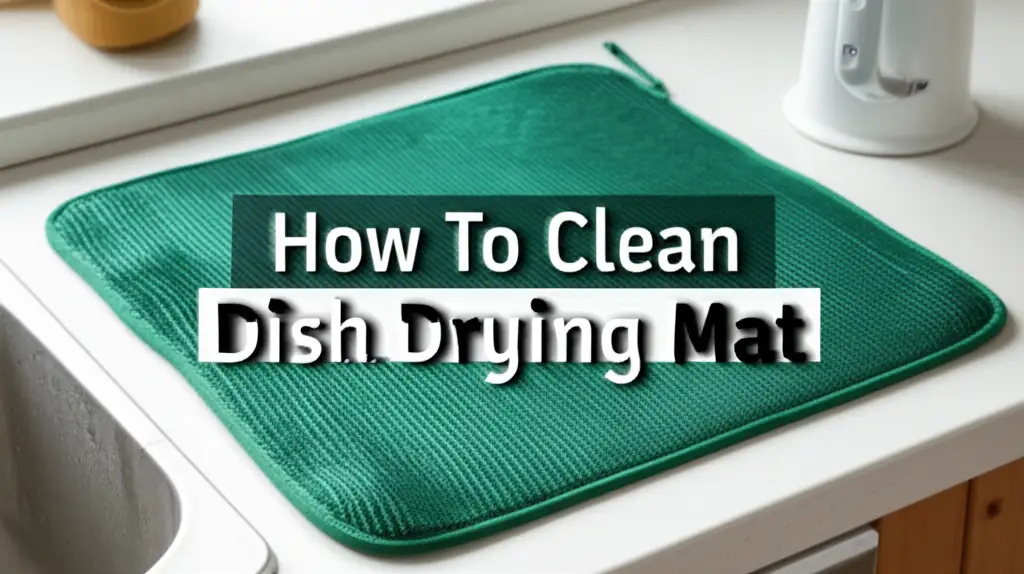· Home Cleaning · 16 min read
How To Clean Straws Inside

How to Deep Clean Straws Inside for Perfect Hygiene
Reusable straws are wonderful for the environment. Many people use them daily. However, a common problem emerges: how to clean straws inside effectively. If you do not clean them properly, tiny food particles and liquids remain trapped. This leads to unpleasant smells and potential health risks.
I understand the frustration of finding gunk inside your favorite straw. It feels impossible to reach. This guide makes the process simple. I will share easy methods and essential tools. You will learn to clean straws inside thoroughly, ensuring they are always fresh and hygienic. We will cover common straw materials and deep cleaning solutions.
Takeaway
- Always use a specialized straw brush to reach inside.
- Wash straws immediately after each use with warm, soapy water.
- Soak straws in a cleaning solution for stubborn grime.
- Rinse straws thoroughly to remove all soap residue.
- Air dry straws completely before storage to prevent mold.
To clean straws inside, use a long, narrow straw brush with warm, soapy water. Push the brush through the straw multiple times from both ends. Rinse the straw under running water until no soap residue remains. This method removes debris and prevents buildup effectively.
Why Cleaning Straws Inside Matters So Much
Keeping your straws clean is more important than you might think. A dirty straw hides invisible dangers. Food bits and drinks dry inside, creating a sticky film. This film becomes a breeding ground for bacteria and mold.
Think about what goes through your straw: sugary drinks, milk, smoothies. These items leave residues. Over time, these residues build up. You cannot see this buildup from the outside. If you drink through a dirty straw, you consume these hidden germs. This can cause stomach upset or other health issues. For better cleaning insights, consider how to approach various challenging items, such as how to clean inside a straw.
Beyond health concerns, dirty straws affect taste. Your refreshing iced tea might taste like yesterday’s smoothie. Residue can leave a foul odor. A clean straw makes every drink taste fresh. It ensures you enjoy your beverages as intended. Proper cleaning also extends the life of your reusable straws. Neglecting them causes staining and degradation. This means you replace them more often. This defeats the purpose of using reusable items. My own experience tells me that a few minutes of cleaning saves a lot of trouble later.
Regular internal cleaning maintains hygiene. It also preserves the integrity of the straw material. You invest in reusable straws to be eco-friendly and cost-effective. Taking care of them ensures they serve you well for years. Cleaning is a small task with big benefits.
Essential Tools for Cleaning Straws Inside Effectively
You need the right tools to clean straws inside properly. A simple rinse does not work. Particles cling to the inner walls. Specialized tools reach every part. They ensure thorough cleaning.
The most important tool is a straw cleaning brush. These brushes are long and narrow. They have sturdy bristles at the end. The bristles scrub the inner surface of the straw. Different sizes are available for different straw diameters. Ensure your brush fits snugly inside your straw. A loose brush will not clean well. A too-tight brush will not go through. My own collection includes a few different sizes. This ensures I always have the right one.
Some straw sets include their own brushes. If yours did not, you can buy them separately. Look for brushes with durable nylon or silicone bristles. These materials resist wear. They also dry quickly. Metal handles are strong and easy to hold. They last longer than plastic ones. You need a brush that stands up to regular use. Consider a plastic straw cleaning guide for specific care instructions.
Other helpful tools include:
- Small bottle brushes: These work well for wider straws, like those found in tumblers. They are often sturdier than standard straw brushes.
- Pipe cleaners: These are a quick fix for very narrow or oddly shaped straws. They bend easily to navigate curves. However, they are less abrasive than brushes. They work best for light cleaning.
- Dish soap: Mild dish soap is essential. It cuts through grease and food residue. Choose an unscented soap if you prefer. Strong detergents can leave a taste.
- Warm water: Warm water helps dissolve stuck-on grime. It also helps rinse away soap. Using cold water alone is not as effective.
Having these tools ready makes the cleaning process quick. You will feel confident your straws are truly clean. I always keep my straw brushes next to my dish soap. This reminds me to clean them immediately after use.
Step-by-Step Manual Washing for Reusable Straws
Cleaning your reusable straws by hand is the most effective method. It ensures you reach every corner. This process is straightforward. It does not take much time. I always recommend this approach for optimal hygiene.
First, rinse the straw immediately after use. Run warm water through the straw. This washes out loose particles. It prevents food from drying and sticking inside. Do this as soon as you finish your drink. Dried residue is much harder to remove. This simple first step saves effort later.
Next, prepare your cleaning solution. Fill a small bowl or sink with warm water. Add a few drops of mild dish soap. Swirl the water gently to create suds. You want enough suds to cover the straw. Dip your straw cleaning brush into the soapy water. Ensure the bristles absorb some soap. This prepares the brush for scrubbing.
Now, it is time to scrub the inside. Insert the straw brush into one end of the straw. Push the brush all the way through until it comes out the other side. This action pushes out any trapped debris. Pull the brush back out slowly. Repeat this action several times. Make sure you push the brush through from both ends of the straw. This ensures thorough cleaning. You want to see the bristles emerge clean from both sides. For more detailed insights on deep cleaning, you might find this guide helpful: how to clean inside a straw.
Finally, rinse the straw thoroughly. Hold the straw under running warm water. Let the water flow through the straw until no soap bubbles appear. You want to remove all soap residue. Swirl the straw around to dislodge any remaining bits. After rinsing, air dry the straw completely. Place it upright in a drying rack. You can also lay it on a clean towel. Ensure it dries fully before storage. This prevents mold and mildew growth. My family members always know to follow these steps. It keeps our straws spotless.
Deep Cleaning Methods for Stubborn Buildup
Sometimes, regular washing is not enough. Stubborn residue or discoloration can build up inside straws. This happens if you skip cleanings or drink thick liquids. When this occurs, you need a deeper approach. These methods tackle tough grime effectively.
Soaking is an excellent first step for deep cleaning. Fill a container with warm water. Add a tablespoon of baking soda and a few drops of dish soap. Baking soda acts as a gentle abrasive and deodorizer. Submerge your dirty straws completely in this solution. Let them soak for at least 30 minutes. For heavily soiled straws, leave them to soak overnight. The soaking process loosens dried-on particles. This makes them easier to remove. I often use this method for straws I forgot to clean immediately.
For even tougher stains or smells, try a vinegar solution. White vinegar is a natural disinfectant and powerful cleaner. Mix equal parts white vinegar and warm water in a bowl. Soak your straws in this mixture for an hour. Vinegar breaks down mineral deposits and mold. After soaking, use your straw brush to scrub the inside. You will find that the buildup comes off more easily. Always rinse thoroughly after using vinegar. You want no vinegar taste left behind. This step ensures your straw is fresh.
Consider using a small amount of rubbing alcohol for extreme cases. Apply it to your straw brush. Scrub the inside of the straw. Alcohol disinfects and dissolves oils. Use this sparingly, as it can be strong. Always follow with a very thorough soap and water wash. Rinse the straw many times. You must remove all alcohol residue. This method works well for plastic or metal straws. Avoid it for bamboo or silicone, as it might degrade the material. After any deep cleaning, always ensure the straw is completely dry before storing. This prevents new problems from forming. These powerful methods ensure your straws are truly clean, no matter the grime.
Cleaning Different Types of Reusable Straws
Reusable straws come in various materials. Each material has unique cleaning needs. Understanding these differences helps you clean them properly. It also extends their lifespan. I have used many types of straws over the years.
Stainless Steel Straws
Stainless steel straws are durable and popular. They do not retain flavors. They are also rust-resistant. To clean them, use a straw brush with warm, soapy water. Push the brush through both ends. Rinse thoroughly. Stainless steel can go in the dishwasher, but hand-washing with a brush is more effective for the inside. Dishwashers may not reach all internal surfaces. If you have straws that integrate with water bottles, learning how to clean straws in water bottles is also very useful. Always air dry stainless steel straws completely. This prevents water spots.
Silicone Straws
Silicone straws are flexible and soft. They are great for kids. They are also less likely to damage teeth. Silicone can attract lint and dust. Wash silicone straws with warm, soapy water and a brush. Their flexibility helps the brush reach inside easily. Silicone is generally dishwasher safe. However, I prefer hand-washing for best results. It ensures no residue remains. Hang them to dry or place them on a rack. Silicone dries quickly. Make sure they are fully dry to prevent mildew.
Glass Straws
Glass straws are elegant and clear. You can see if they are clean. They offer a pure taste experience. Glass is fragile, so handle with care. Use a straw brush gently with warm, soapy water. Avoid extreme temperature changes. This prevents cracking. Glass straws are dishwasher safe. Place them in the utensil basket. However, hand washing gives me better peace of mind. Ensure they dry on a flat surface or a very secure rack. This prevents breakage.
Bamboo Straws
Bamboo straws are natural and biodegradable. They require special care. Do not put bamboo straws in the dishwasher. The high heat and harsh detergents damage the natural material. Hand wash bamboo straws with warm, soapy water and a brush. Rinse them immediately. After washing, dry them thoroughly. Air dry them completely in a well-ventilated area. Avoid soaking bamboo straws for long periods. This can cause mold or cracking. Store them in a dry place. Proper care makes bamboo straws last longer.
Plastic Straws
Reusable plastic straws are lightweight and affordable. They can stain over time. They also might retain odors. To clean them, use warm, soapy water and a straw brush. Scrub the inside thoroughly. Plastic straws can go in the dishwasher. Place them in the utensil basket. However, intense heat from a dishwasher might warp some plastics. I often choose hand washing to avoid this. Ensure they dry completely before storage. Proper care for plastic straws extends their usefulness. Different materials require attention. My knowledge of each helps me keep all my straws in top condition.
Maintaining Clean Straws and Preventing Future Issues
Keeping your straws clean is an ongoing process. It is not just about deep cleaning occasionally. Regular maintenance prevents grime buildup. This saves you time and effort in the long run. I follow a simple routine. This keeps my straws ready for use.
The best defense is immediate cleaning. Wash your straw right after each use. Do not let liquids dry inside. Food particles stick to the walls quickly. A quick rinse and scrub with a brush prevents this. This proactive step stops most issues before they start. My golden rule is: “If you used it, clean it now.” This habit makes a big difference.
Proper drying is crucial. After washing, ensure your straw dries completely. Trapped moisture leads to mold and mildew. Place straws upright in a drying rack. You can also lay them on a clean towel. Air circulation helps them dry faster. Do not store a damp straw. This applies to all materials. A wet straw stored in a drawer will get moldy. This becomes unsanitary. I always check for dryness before putting them away.
Store your clean, dry straws properly. Use a clean, dry container or drawer. Avoid storing them in a humid area. A dedicated straw holder works well. This keeps them dust-free. It also protects them from external contamination. Proper storage means they stay clean until next use.
Regularly inspect your straws. Look for signs of wear, discoloration, or persistent odors. If a straw has permanent stains or smells, it might be time to replace it. Some materials, like silicone, can eventually absorb flavors. Bamboo can splinter or grow mold if not maintained strictly. My own practice includes a quick visual check before and after each use. This ensures I catch any problems early. A little attention goes a long way. This keeps your straws hygienic and extends their usability.
Common Mistakes to Avoid When Cleaning Straws
Many people make small errors when cleaning straws. These mistakes can lead to ineffective cleaning or damage. Avoiding them ensures your straws stay clean and last longer. I learned these lessons through experience.
One common mistake is relying solely on the dishwasher. Dishwashers are convenient. However, they often do not clean the inside of straws effectively. The powerful jets might not reach the narrow interior. Food particles and residue can remain stuck. Always use a straw brush for the internal cleaning. Even if your straw is “dishwasher safe,” manual scrubbing is superior for hygiene. I never trust my dishwasher alone for this task.
Another error is not using a straw cleaning brush. Some people try to clean straws with water pressure alone. Others might use a pipe cleaner that is too thin. These methods do not provide enough scrubbing action. A proper straw brush reaches every part of the inner wall. Its bristles remove stubborn debris. Without a dedicated brush, you are only rinsing the surface. This leaves hidden grime. Always have the right tool. My personal rule is: no brush, no clean straw.
Forgetting to rinse thoroughly is a frequent oversight. After washing with soap, some residue can remain. If you do not rinse completely, you might drink soap with your next beverage. This tastes bad and can be unhealthy. Always run plenty of clean water through the straw. Keep rinsing until no bubbles or slippery feel remain. I always hold the straw up to the light to check for clarity after rinsing.
Not drying straws completely is a major mistake. As mentioned, moisture leads to mold and mildew. This is especially true for materials like silicone and bamboo. Some people put wet straws directly into a drawer. This traps humidity. Always allow straws to air dry fully. Use a drying rack or lay them on a clean towel. Patience here prevents future headaches.
Finally, ignoring the type of straw material is an error. As discussed, bamboo needs different care than stainless steel. Putting a bamboo straw in the dishwasher ruins it. Using harsh chemicals on certain plastics can degrade them. Always read the manufacturer’s cleaning instructions. My advice is simple: know your straw. This knowledge prevents damage. Avoiding these common errors will make your straw cleaning more effective. It also ensures your reusable straws last for many years.
Frequently Asked Questions About Straw Cleaning
How often should I clean my reusable straw?
You should clean your reusable straw immediately after every single use. This prevents food and drink residues from drying and building up inside. Daily cleaning ensures optimal hygiene and prevents unpleasant odors. Neglecting immediate cleaning makes deeper cleaning necessary later.
Can I put reusable straws in the dishwasher?
Most stainless steel, silicone, and glass straws are dishwasher safe. However, dishwashers do not always clean the inside effectively. Manual cleaning with a straw brush is always recommended for the interior. Bamboo straws should never go in the dishwasher; they require hand washing.
What if my straw still smells after cleaning?
If your straw still smells, it likely has stubborn residue or mold inside. Try a deep cleaning method. Soak the straw in a solution of warm water, baking soda, and a few drops of dish soap for several hours. For persistent odors, soak it in a white vinegar and water solution. Always scrub with a brush afterward.
How do I dry straws to prevent mold?
After washing, ensure straws dry completely to prevent mold. Place them upright in a drying rack, allowing air to circulate inside and out. You can also lay them on a clean towel. Do not store them in a closed drawer or container until they are bone dry.
What kind of brush do I need for my straws?
You need a long, narrow straw cleaning brush with firm bristles. These brushes come in various diameters. Choose one that fits snugly inside your specific straw to ensure effective scrubbing. Many reusable straw sets include a suitable brush.
Is it safe to use bleach to clean straws?
No, using bleach to clean reusable straws is not recommended. Bleach is a harsh chemical. It can be difficult to rinse completely from the straw’s interior. Ingesting bleach residue can be harmful. Stick to mild dish soap, baking soda, and vinegar for safe and effective cleaning.
Conclusion
Keeping your reusable straws clean inside is a small task with significant benefits. We explored why this cleaning is so important for your health and the lifespan of your straws. We covered the essential tools you need, primarily the indispensable straw cleaning brush. I showed you the straightforward steps for daily manual washing. We also discussed powerful deep cleaning methods for those stubborn situations.
Remember, each straw material has specific care needs. Understanding these ensures proper cleaning. Avoiding common mistakes like relying only on dishwashers or neglecting complete drying will save you time and effort. By following these practical tips, your reusable straws will remain sparkling clean and hygienic. Make cleaning your straws a consistent habit. Your health will thank you.
Ready to make your cleaning routine even better? Explore more ways to keep your kitchen spotless. Visit BeaCleaner.com for comprehensive cleaning guides and tips. Start enjoying truly clean straws today!
- reusable straws
- straw cleaning tips
- deep clean
- kitchen hygiene




